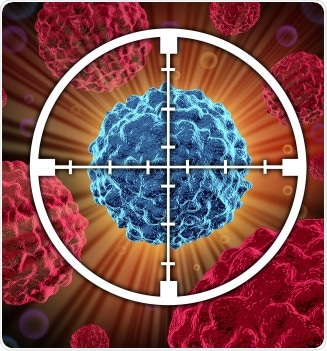Researchers have demonstrated a type of cellular binding that could lead to highly targeted treatments against diseases like cancer.

“Range selectivity” could be used to target diseased cells with high specificity. Image Credit: Imperial College London.
A growing field of medicine looks at how cellular binding seen in nature—where molecules, such as proteins or viruses, attach to certain receptors on a cell—can be imitated to support drug delivery.
Scientists who are developing targeted drug treatments aim to reproduce this precise cellular binding to create nano-sized drug carriers that bind only to the diseased cells. As soon as these carriers are attached, they would discharge their therapeutic load without impacting the healthy cells. If medications are particularly targeted in this way, treatments may lead to fewer adverse effects.
One method to find out which cells are diseased is through the number of receptors expressed by them. For instance, cancer cells tend to express more certain types of receptors than healthy cells.
In a multi-center collaboration headed by Imperial College London and UCL, scientists have recently demonstrated how an elusive molecular concept, dubbed “range selectivity” by the authors, could be utilized to target diseased cells with high specificity.
To date, range selectivity, which has remained an elusive phenomenon, is where the molecules known as ligands bind only to cells, whose receptors reach a specific threshold.
I came across the concept of range selectivity completely by accident. During my theoretical investigation of receptor-ligand binding I noticed that ligands weren’t attaching above a certain threshold of receptor density and had my team re-check our code before realising it wasn’t a bug.”
Dr Stefano Angioletti-Uberti, Study Senior Author and Principal Investigator, Department of Materials, Imperial College London
Range selectivity occurs in nature due to a balance of repulsive and attractive forces at the molecular level. Beyond a specific threshold, the repulsive force should outweigh the attractive one, and hence attachment is relatively less likely to occur. This can be attributed to the specific physical properties of ligand-receptor interactions.
Once the researchers from Imperial College London realized this phenomenon, they employed statistical mechanical modeling to demonstrate that altering certain parameters could adjust the balance of repulsive and attractive forces. This offered a “molecular handle” to modify the lower and upper limits of the selectivity range. The UCL collaborators, headed by Professor Giuseppe Battaglia, subsequently confirmed these theoretical predictions with the help of experimental data.
The study results have been published in the Nature Communications journal and include contributions from Beijing University of Chemical Technology, the Institute of Physics in Beijing, and the Institute for Bioengineering of Catalonia.
The key to unlocking highly targeted drug therapies could lie in directing drug carriers towards cells with a precise number of receptors. If we can find out which receptor densities are specific to different diseases and apply what we’ve demonstrated to drug carriers, we could treat those diseases effectively with fewer side effects.”
Dr Stefano Angioletti-Uberti, Study Senior Author and Principal Investigator, Department of Materials, Imperial College London
Cancer clues
Alongside drug targeting, the team stated that their study provides a significant insight that could transform the way future research is performed in this field. For instance, scientists could now consider that merely increasing the number of receptors does not essentially increase the likelihood of binding, and in fact, may cause it to decrease considerably.
It also provides clues that could somehow explain why tumors have the ability to avoid attacks from the immune system.
Could it be that tumour cells’ receptor densities fall outside the range toward which immune cells are programmed to target?”
Dr Stefano Angioletti-Uberti, Study Senior Author and Principal Investigator, Department of Materials, Imperial College London
The study’s authors are currently exploring ways to optimize the receptor density on cells to ensure the highest binding, since several parameters like the type of ligands and receptors can impact the strength of these bonds.
“Nature might already be using this form of binding to its own advantage, or indeed our disadvantage. Understanding this fully could lead to a wealth of disease-targeting possibilities,” Dr Angioletti-Uberti concluded.
Source:
Journal reference:
Liu, M., et al. (2020) Combinatorial entropy behaviour leads to range selective binding in ligand-receptor interactions. Nature Communications. doi.org/ 10.1038/s41467-020-18603-5.